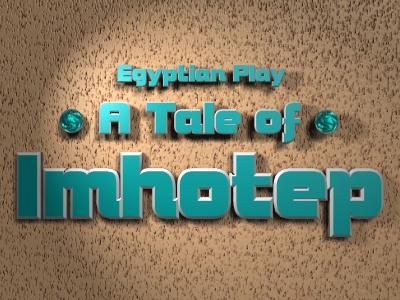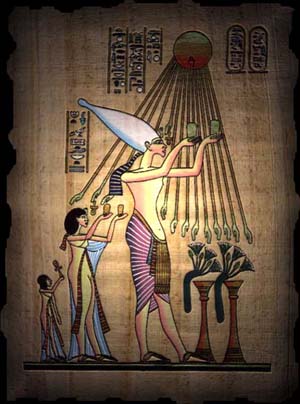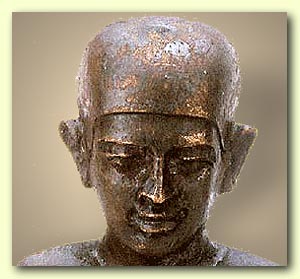A Tale of Imhotep
![]()
|
|
| |
Back to Index Page |

![]()
![]() By LuisE. Prada
By LuisE. Prada
Editor and Publisher of Brother Veritus’ Website
Director of Brother Veritus’ Community
Egyptian Play, A Tale of Imhotep
Note: Pharaoh Djoseris also known as Zozer.
![]()
CHARACTERS:
Sabber and Konozer-Horeb are two priests of the Temple of the Sunat On(1) and close friends.A vestal virgin and chantress prepares the offering table.
BACKGROUND:
Sabber has been absent to Nubia for almost a year fulfilling adiplomatic mission entrusted by the Pharaoh Akhnaton. Upon arrival he went to the Templeand there he finds his old friend Konozer-Horeb when he had just finished an afternoonoffering to the Sun God Aton.
TECHNICIANS:
Play music at proper times and control lights.
COSTUMES:
Both actors will wear Egyptian costumes of lector priests withthe following elements: Headdress, collar, sash, bracelets and anklets, bare torso andsoft linen kilt with ceremonial apron and sandals. Vestal virgin wears an appropriateEgyptian costume with long linen dress, collar, bracelets, anklets and girdle. Delineatedand blue shadowed eyes for makeup.
ACCOUTREMENT:
* The symbol of Aton is shown on the East, a winged solar disk
* Offering table at the East
* Incenser and incense located at the center of the offering table
* Basin with water and white towel cloth
* Bowl with fruits and bouquet of flowers
* A lectern with the lyrics of a song. It is placed at the left of the offering table
TIME AND SCENE:
The scene happens during Akhnaton’s time (circa 1350B.C.) beforethe construction of the city of AkhetAten (today’s Tel El Amarna). At the West of theTemple of On the antechamber door opens and a chantress enters the temple carrying on herhead a bowl of fruits that she holds with her right hand while with her left carries awhite towel cloth and a basin with water that she presses against her hip as she walks.Light is dimmed and a spot light follows her. She looks graceful as she walks toward theoffering table. There she places the bowl of fruits to the right and to the left the basinof water and the towel cloth. Then she moves to the center of the table, places someincense in the incenser and lights it. Finally she moves to a temple secluded place andsits unseen.
Technician plays entrance music. The antechamber door opens againand Konozer-Horeb, an orator and chanter priest, enters and walks to the East to the altarof offerings. Light follows the priest. Before positioning at the altar, he removes hissandals and moves to the left to the bowl of water were he makes a sacred ablution of faceand hands (the music stops when the ablution starts.) The priest dries his face and handswith the towel cloth and moves to the center of altar.
![]()
Temple of the Sun, City of Heliopolis
KONOZER:
Placed at the center of the altar, he stokes up the incense fire.Lifting the incenser offers the smoke to Aton and says this first Hotep-di-Nesusalutation:
A priestly offering is given to Aton, that sustenance might comeforth for the spirit of Konozer-Horeb.(2)
Speaking in Egyptian he makes a second Hotep-di-Nesu salutation:
“Hotep-di-Nesu Pa-Aton em Akhet,
Peret-kheru ta henket kau apedu,
En ka en remetch nebu em AkhetAten djet er neheh."
After the priest has finished the Egyptian words, the technician plays a recording of their translation given below:
Translation:
A royal offering which is givenTo the Sun Disk in the Horizon,
That there might come forth bread and beer, oxen and fowl,
For the spirit of all the people in AkhetAten for ever and ever.
Placing the incense back on the table, in silence does the offering of the bowl of fruits.
 Now looking at the image of the Sun disk, he extends his handssaluting the divinity while recites a prayer in an eloquent way. Technician playsappropriate Egyptian-style music for background:
Now looking at the image of the Sun disk, he extends his handssaluting the divinity while recites a prayer in an eloquent way. Technician playsappropriate Egyptian-style music for background:
“How splendidly You arise,
O, Living Aten,
Everlasting Lord,
Your love is great and expansive,
Your rays illumine every face.
Your brilliance gives life to every heart
When You fill the two lands with Your love.
“Most Noble God Who created Himself,
Who made every land and what is in them,
All peoples, herds and flocks,
Every tree which grows from the soil,
They live when You dawn for them.
You are the Mother and Father
Of all that You have made.” (3)
Now, Konozer chants AUM three times. When chanting starts, Sabberenters the temple via the West portal and walks in the dim light to the East. AfterKonozer has finished his chanting bows to the divinity with arms crossed over his breast.Then he turns to find his friend Sabber.
KONOZER:
Sabber! My dear friend!(Hecrosses his arms over his breast and bows while speaking, Sabber returns the greetingswith a similar bow:)Joy and blessings be unto you.(They approach and embrace each other.)Happyare the eyes that behold you after such a long absence!
SABBER:
Konozer-Horeb! I was absent only in body but not inheart. My thoughts were always with Our Beloved Pharaoh, with you, with the Brethren ofthe School and our loved ones.
KONOZER:
I hope you will illustrate me about such animportant trip and the life in that far Nubian land. I see that you came in one piece too!Did they treat you… friendly?
SABBER:
O, yes!, they did. I received great honors and respectas a representative of Our Beloved Pharaoh Akhnaton, Live, Prosper and Be Healthy! We willfind enough time to discuss all details of my visit to Nubia.
KONOZER:
Surely we will. Sabber, last afternoon while I waswalking and meditating by the Nile shore, night came upon me and I saw several campfiresmade by a group of oarsmen and dragomans. The dragomans had unloaded their cargo and theoarsmen had loaded them in their boats to ferry them up the river. But due to the advanceof the hour, the dragomans decided to camp with all the caravan by the shore and waituntil early morning to start their trip back to Mennufer(4). Likewise, the oarsmen decided to camp by the shore to part early morningtoo, while guarding their precious cargo. This cargo consisted of expensive materials suchas rings and sheets of gold and silver, alabaster, granite, the finest quality limestone,lapis lazuli and precious green stones to be used in the construction of AkhetAten,"The Horizon of Aten", the new city on the East bank of the Nile in Upper Egypt,facing Un(5) at its West. They also had a collection of gold, silver and bronzestatuary and ornaments.
SABBER:
Yes, I am well aware of this project.
KONOZER:
Well… while passing by, they recognized me as apriest of On and invited me to sit by one of the campfires and partake of their supper. Awoman promptly brought a bundle of sheepskins for me to sit on and I was treated withgreat honor. They asked me questions about the magic in the temple and about how to pleaseSeth and Horus Upon-the-Ways, the gods of the desert and to honor Sobek, the crocodilegod, for better fortune during their trips.
After one of the oarsmen had finished his meal, he took a lute and started to sing a lovesong he had composed. I was so moved by the lyrics and their cadence that, as I finishedmy dinner, I went to him and asked if he repeat for me those lyrics so I could write themdown. This he did while feeling himself so proud to have pleased such an important guestwith his art. I pulled out from my purse a papyrus scroll, my quill pen and ink. He againplayed through that music as I scribbled the verses down.(Withhumor:)Having paid so much attention to it since then, Ihave almost memorized it.(Pointing at the solar disk, hesays:)So many times the Solar Essence expresses itselfthrough the hearts and minds of the humble people!
SABBER:
Yes, indeed.
KONOZER:
This is an example. Would you like to hear it, dearSabber?
SABBER:
Please do so, Konozer.(Sabbersits on the steps of the temple by the East to listen).
KONOZER:
Hopefully the gods will clear my voice after all thechanting I have been doing to them in the Temple of the Sun.(Thishe says with a little humor while moving to the lectern.)
SABBER:
So … are you still holding the Hery-Khebs(6) position ofchanter and orator of the temple hierarchy?
KONOZER:
Yes, I am, until next midsummer.
(Music plays as Konozer sings this song:)
![]()
Rosa
Rosa, as is the color that adorns your hair at the break of dawn.
Rosa, the rose, your name, the color and life are all like you.
Rosa, as was the stroke of that first light that painted land and sea.
Color of time and sacred fire, of ancient lands across the sea,
Of heavens broken up… of immensity!
(Pitch change:)
Rosa, afterglow o’er the pyramids and on the Egyptian land.
Rosa, to think ’bout you is to feel that joy… of felicity!
Rosa, a song that through any desert land just goes along with me,
Unhindered heart like is the wind, feeling an inner joy and peace,
With Goddess Nut… up in the nights… I see my star.
Beloved lady of my heart, why are not you with me tonight
To see that star… and feel the throb… of my heart for you!
(Music)
Rosa, in all the temples and sandy dunes I always search for you.
I call to you, you hear my plea when I’m afar, away from you,
What is the star… that now you are… gazing up?
Unfolding soul of love and peace… of misty immortality,
The rose, your name and the color, always you!
Color of time and sacred fire, of ancient lands across the sea,
Of heavens broken up… of immensity!
Too-roo-roo humm humm… too-roo-roo humm humm… too-roo-roo humm humm… (7)
(Humming to music as it fades away.)
SABBER:
That was good!
KONOZER:
Well, it’s the song, I told you, it is good.(He expresses it modestly.)
SABBER:
The song and your talent.
KONOZER:
(Konozer joins Sabber by sitting on the stairs.)
When we leave the temple I will send an acolyte to my home totell my wife of your arrival. Will you join our family for dinner, so I may ask her toprepare a baked fish with boiled squash and onions as you like. And date cake for dessert!Will you? … we purchased yesterday several vessels of good date wine…
SABBER:
That sounds delicious. Certainly I will. And I maytell your family stories of those far lands I just visited.
KONOZER:
Aha!,(pause … sayspensively:)Sabber, tell me a story on the life of Imhotep,you know how much I enjoyed learning from you about such a great sage of a bygone time. Inthe past, you used to tell me about him, about his skills in constructing the ren ofDjoser or step pyramid at Saqqarah … about the techniques he used to build theunderground labyrinth of galleries and corridors to keep the king’s burial site secret …about his miraculous healing powers …
SABBER:
Certainly.(Inspired hesays:)Imhotep was born as any other child, but when veryyoung was taken by the gods away. After many years and during the third year of the reignof Djoser, Imhotep returned from the abode of the gods. His family rejoiced. His skin hadturned very dark and he had dark-blue symbols at the back of his head, some say thesesymbols gave him his divine powers.
After his return, Imhotep asked and insisted for an audience withthe King. At that time, the Pharaoh Djoser was in a bad mood, since he was troubled byfestering teeth and had lost many of them through decay making it almost impossible toeat. Since Imhotep’s appearance was strange, the king did not beat him or even kill himfor daring to insist in a royal audience when the king was in such a mood. Imhotep askedto be left alone with the Pharaoh. When the court returned, they found the king in goodspirit, his bad teeth were no longer bothering him and within a week he grew another fullset of teeth.(8)
KONOZER:
A new set of teeth? Wow! … Wow!(Konozer touches his cheeks while moving his lower jaw and says:)I wish Imhotep were still around to work on mine!
SABBER:
Since that incident, Imhotep and King Djoser werehardly ever separated. He gained such ascendancy before the Pharaoh that he dared to tellthe king that he could not and would not perform his magic at the king’s command. He washonored with the titles of First of the King’s Household and Grand Vizier.
Let me recite for you this hymn to Imhotep, an archaiccomposition written in a new style and engraved in the Temple of Ptah in Karnak.
(He stands up and says with eloquence:)
|
“Hail to you, kind hearted god, |
And for now, don’t forget your promise of the dinner. I think Ineed it.(He places an open hand on his stomach).
KONOZER:
O, certainly not!(Konozerraises followed by Sabber and moves to put his sandals back on while speaking:)Let’s go to the room annex to the hypostyle hall. I will show you thescript of a drama I am writing for the coming series of initiation ceremonies in theTemple of On while we wait to be called for dinner. I have been told that a good number ofpostulants are pleading admittance into our mysteries … some are coming from as far asthe Helens and Summer.(As they walk to the West door the spotlight follows them and exit music sounds. They open the door and enter into theantechamber.)
The vestal virgin approaches the left of the table and takes thewater basin and the towel cloth. She holds them with her left hand while pressing thebasin against her hip and walks toward the West portal. She enters the antechamber. Exitmusic may continue while actors return to stage to bow and acknowledge the audienceapplause.
END OF THE EGYPTIAN PLAY
![]()
References
1. Also known as An, the City of the Sun, calledHeliopolis by the Greeks. The Temple of the Sun was called in Egyptian Hwt-Benben.
2. Five Fascinating Artifacts, by Lynn Holden, Egyptologist and Ex-curator of theRosicrucian Egyptian Museum, published by the Rosicrucian Digest, 1996, No. 3. Here I haveparaphrased the famous Hotep-di-Nesu formula. The second Hotep-di-Nesu formula in Egyptianand its translation was given to me by Dr. Holden. Here I want to express special thanksto him for his historical contributions to this play.
3. Interactive Ancient Egypt, in CD-ROM by Lynn Holden. The translation here is by Dr.Holden.
4. Memphis.
5. Hermopolis.
6. Arcadia, Studies in Ancient Wisdom, by Peter Dawkins, published by The Francis Bacon Research Trust. See Part I: Chapter The Egyptian Mysteries of Initiation, Section"The Offices", pages 62 through 66. In this book the chanter position is calledOdos, here I am using its equivalent Egyptian name.
7. This song uses the music of the Spanish song "Rosa" sang by the Italiansinger Nicola Di Bari. The star referred to here is Septet or Sopdet (Sirius).
8. ET Connections Through Alien Eyes, Part 3, by Wesley H. Bateman, Federation Telepath,Chapter Imhotep, published by in the magazine Sedona, Journal of Emergence, Vol. 6, No. 6,June 1996, P.O. Box 1526, Sedona, AZ 86339, U.S.A.
9. Ancient Egyptian Literature, Vol. III, by Miriam Lichtheim, published by the Universityof California Press, Berkeley, 1980, Part I, Chapter IV: "Hymns andLamentations", page 105. The text given here was adapted by Lynn Holden from variousplaces of Lichtheim’s translation.
![]()
